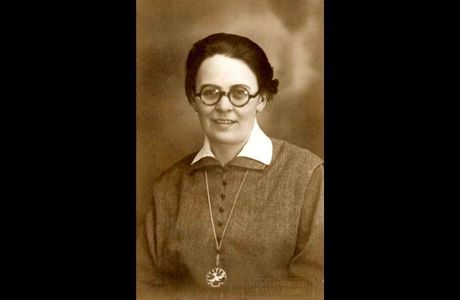
Sara Salkahazi was a Hungarian Catholic journalist who saved one hundred Jews during the Holocaust and paid the ultimate price for her bravery.
Born to a German family in Kassa, Hungary (now Slovakia) in 1899, Sara was described by her brother as a “tomboy with a strong will and a mind of her own.” A high-energy woman who spoke several languages, Sara worked as an elementary school teacher, a bookbinder and a hatmaker before becoming a journalist and editor of the National Christian Socialist Party of Czechoslovakia. She wasn’t particularly religious and considered herself agnostic or even atheist.
In 1929, Sara’s life changed when she discovered the Sisters of Social Service, a Catholic religious order founded in Hungary in 1923. After World War I, social upheaval and economic disaster created widespread poverty and suffering, and the SSS’s mission was to alleviate human suffering, especially among women and children. Sara attended a meeting of the group, and was deeply inspired. These women of faith were truly making a difference, and Sara knew she had to be part of it. Sara didn’t do anything in life halfway, and within a year of that first meeting, Sara took her first vows on Pentecost 1930. Her personal motto became, “Here I am; send me!”
Sara began working at the Catholic Charities office in her hometown, where she managed the bookstore, organized charitable drives, and published a magazine called “Catholic Women.” Never afraid of undertaking ambitious projects, she organized all the Catholic women’s groups into a Catholic Women’s Association. As part of this effort, Sara also started the National Girls Movement. As a working woman, Sara had a particular affinity for other girls and women who worked, either out of necessity or choice. She started a women’s vocational college, a home for working girls, and a series of training courses. Meanwhile Sara continued writing, including a popular play on the life of St. Margaret of Hungary.
Unfortunately, as a chain-smoking ex-atheist journalist, Sara didn’t fit in with the other Sisters and this became a problem. The more she achieved, the more others unfairly suspected she was just trying to draw attention to herself. They doubted she truly had a vocation to lead the religious life, and they actually refused to allow her to renew her vows or to wear the habit for a year. Stung by the rejection, Sara considered leaving the order, but ultimately decided to continue her work as a Sister of Social Service, even without an official vow or a habit. She made plans to relocate to Brazil, where a Hungarian Benedictine convent was looking for Sisters to assist their mission, but before she could move, World War II broke out and Sara found a new mission, which would define the rest of her life.
As Hitler rose to power in the 1930’s, so did his close ally the Hungarian Nazi party, also known as the Arrow Cross. Around this time, as a form of protest, Sara changed her German-sounding name to the Hungarian version. The Arrow Cross’ path to power in Hungary began with recruiting the poorest and most marginalized members of society, including alcoholics, ex-cons, career criminals, sex offenders, and those with mental health issues that made it impossible to hold down a job. The Arrow Cross whipped up their followers to commit violence against Jews, intellectuals, and others who spoke out about their fascist reign of terror.
In response to the growing persecution of Jews, Sara sprang into action. She turned her Working Girls Homes into safe havens for Jews desperate to escape the Arrow Cross. She housed at least a hundred Jews in buildings belonging to the Sisters of Social Service, often right under the nose of the Gestapo. Absolutely devoted to the cause of saving Jews, Sara made a formal pledge to God to sacrifice herself if the other Sisters weren’t harmed. This text survived the war.
Tragically, Sara was betrayed by a woman working in one of the safe houses. While Sara was out, the Arrow Cross stormed the building. Sara heard about what was happening, and could have run away and stayed safe. Instead she made the fateful decision to return. Sara was arrested by the Gestapo that day, along with four Jewish women and a Christian co-worker. The six women were marched to the bank of the Danube River on December 27, 1944, where they were shot and dumped into the water. Sara’s body was never recovered. She was 45 years old.
This horrific event was kept secret until 1967, when the belated trial of some Arrow Cross members revealed the details of their crimes against humanity. Two years later, the daughter of one of the Jews killed alongside Sara nominated her to Israeli Holocaust Memorial Yad Vashem as a Righteous Gentile, and she received this posthumous honor in 1969.
In 2006, Sara was beatified by Pope Benedict XVI, who said “She was willing to assume risks for the persecuted in days of great fear. Her martyrdom is still relevant, and represents the foundations of our humanity.” Abraham Foxman, a Holocaust survivor saved by his Catholic nanny, said “The honor bestowed by Pope Benedict XVI on Sister Sara Salkahazi for risking and eventually giving her life to save Jews in peril is an important statement by the church. It is unfortunate that there were not more individuals like Sister Sara, but her example must be held up to demonstrate how lives can be saved when good people take action to confront evil.”
For sacrificing her life to save a hundred Jewish strangers, we honor Sara Salkahazi as this week’s Thursday Hero.
Get the best of Accidental Talmudist in your inbox: sign up for our weekly newsletter.